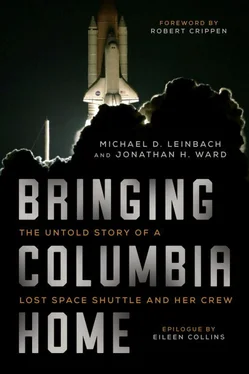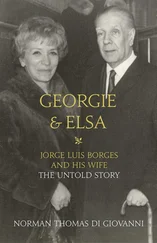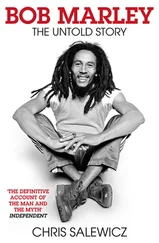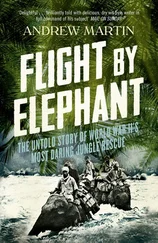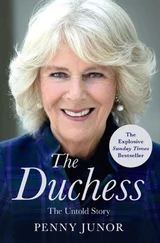February 1, 2003
Mike Leinbach, Launch Director
Twin sonic booms in rapid succession—one from the space shuttle’s nose and one from its vertical tail—were always the fanfare announcing the arrival of the majestic winged spacecraft. Three minutes and fifteen seconds before landing, as the shuttle glided toward Kennedy Space Center (KSC), the loud and unmistakable double concussion would be heard up and down Florida’s Space Coast. These booms would be our cue to start scanning the skies for our returning spacecraft, descending toward us at high speed in the distance.
Columbia and her crew of seven astronauts were coming home from sixteen days in orbit. After six million miles circling the Earth, they had reentered the atmosphere over the Pacific Ocean, crossed the California coast, and then flown over the Desert Southwest and Texas en route to Florida. These last few miles would be her victory lap in front of her astronaut crew members’ families and the KSC personnel who tended her on the ground.
As KSC’s launch director, I was one of the officials who would welcome Columbia home when she landed at 9:16 this cool morning. At 9:12, we listened and waited for the thunderous sonic booms, which would sound like the percussion of an artillery volley. But today the heavens were strangely silent.
Over the loudspeaker feed from Mission Control, we heard repeated calls to the crew: “ Columbia, Houston. Comm check.” Long moments of silence punctuated each call. “ Columbia , Houston. UHF comm check.”
I was confused and alarmed. I looked up at the clouds and turned to Wayne Hale, NASA’s former ascent and entry flight director, and asked him, “What do you think?”
He thought for a moment and responded with a single word: “Beacons.”
That one word hit me hard. The astronauts’ orange launch and entry suits were equipped with radio beacons in case the crew needed to bail out during a landing approach. Hale clearly knew the crew was in trouble. He was already thinking about how to find them.
My God .
The landing countdown clock positioned between the runway and us ticked down to zero. Then it began counting up. It always did this after shuttle landings, but we had never really paid attention to it because there had always been a vehicle on the runway and that clock had become irrelevant.
The shuttle is never late. It simply cannot be.
Columbia wasn’t here. She could not have landed elsewhere along the route. She was somewhere between orbit and KSC, but we didn’t know where.
I tried to sort out my thoughts. Something was horribly wrong. An indescribably empty feeling swept over me. My position as launch director was one of knowledge and control. Now I had neither.
Kennedy Space Center and Cape Canaveral have seen more than their share of disasters. A launch catastrophe is unmistakable—tremendous noise, a horrendous fireball, and smoking debris falling into the ocean. My mind flashed back to the frigid morning of January 28, 1986. I had been standing outside and seen Challenger lift off from pad 39B, only to disappear into a violent conflagration shortly afterward. I remember expecting—hoping—that Challenger would emerge from the fireball, fly around, and land behind me at the Shuttle Landing Facility. But we never saw Challenger again. I recalled leaving the site with a few friends as debris and smoke trails continued to rain down into the Atlantic, just off the coast. It was a terrible thing to witness.
This situation was completely different. Our emergency plans assumed that a landing problem would happen within sight of the runway, where a failed landing attempt would be immediately obvious to everyone. Today, there was nothing to see, nothing to hear. We had no idea what to do.
Columbia simply wasn’t here.
We all knew something awful must have happened to Columbia , but our senses could tell us nothing. The audio feed from Mission Control had gone eerily silent.
The breeze picked up. Low rippling clouds masked the sun. The quiet was broken only by a few cell phones that began ringing in the bleachers where spectators and the crew’s families were waiting. The astronauts in the ground support crew huddled briefly by the convoy command vehicle. Then they moved with quick determination toward the family viewing stand.
I glanced over at Sean O’Keefe, NASA’s administrator. He appeared to be in shock. O’Keefe’s associate administrator, former astronaut Bill Readdy, stood at his side. Readdy looked me in the eye and asked, “Contingency?” Unable to speak, I simply nodded.
Readdy carried a notebook containing NASA’s agency-wide contingency plan for spaceflight emergencies. Ever the pragmatist, O’Keefe had ordered this plan updated within hours of becoming administrator in late 2001. Now, barely one year later, the plan had to be activated. The procedures designated Readdy to make the official call. He told O’Keefe that he was declaring a spaceflight contingency.
Gathering my thoughts and trying to keep my emotions in check, I told the officials to meet me in my office back at the Launch Control Center (LCC), about two and a half miles to the south. We could confer there in private and get more information about the situation.
KSC security personnel and astronaut escorts quickly led the crew’s families away from viewing stands to a bus that would take them to the privacy of the crew quarters. The other spectators—many of whom were friends of the crew or members of the crew’s extended families—were also ushered to waiting buses.
There was no announcement of what had happened, but everyone knew that it must be something dreadful. Few words were spoken. People wept and hugged one another as their initial emptiness slowly filled with grief.
In the utterly inadequate jargon of astronauts and space workers, this was going to be a bad day .
As I hustled back to my vehicle, I had no idea how this horrible day would unfold—or how inspiring its aftermath would ultimately be.
Chapter 2

GOOD THINGS COME TO PEOPLE WHO WAIT
I began my twenty-seven years with NASA in 1984 as a structural engineer. With an undergraduate degree in architectural design and a master’s in structural engineering—both from the University of Virginia—I was living my childhood dream! I couldn’t believe I was working at Florida’s Kennedy Space Center, designing portions of the launchpad platforms, emergency escape systems, and the like. I moved into an operations role shortly after the Challenger accident, becoming a NASA test director and a member of the shuttle launch team. I moved up fairly quickly and eventually was leading the launch countdown.
After a two-year stint as deputy director of the International Space Station Program Office at KSC, I became the eighth launch director of the Space Shuttle Program in August 2000. I was now responsible for all shuttle launch operations, including giving the final “Go”—or often “No-go”—for launch.
Through it all, I never lost touch with friends made along the way, nor did they stop reaching out to me. I like to think I was just a regular KSC guy who got a big job.
Some of my predecessors had a sort of old-school management style that entailed demanding action and acting aloof toward junior personnel. However, my openness, combined with coming up through the ranks as I did, earned me the moniker “the people’s launch director.” I was no overbearing type—but I was also no pushover. People always knew where they stood with me and what I expected of them. I publicly recognized superior performance, and also did some course correcting when necessary. It was a combination that worked well for the team and me. Together, we accomplished amazing things.
Читать дальше
